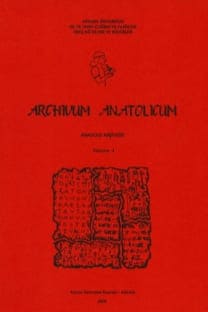NAM.RA’ların Kullanımına Hitit Metinlerinden Örnekler
Samples about Using of NAM.RA from Hittite Texts
Hittites NAM.RA, Economy, Population policy,
___
- Alp 1949: S. Alp, “Hititlerde Sosyal Sınıf NAM.RA'lar ve İdeogramın Hititçe Karşılığı”, Belleten 13, ss. 245-270.
- Archi-Klengel 1980: A. Archi-H. Klengel, “Einhethitischer Text über die Reorganisation des Kultes”. Altorientalische Forschungen 7, ss. 143-158.
- Arıkan 2000: Y. Arıkan, “Hitit Belgelerinde Körler”, in: Archivum Anatolicum 4, ss. 207-224.
- Bryce 2003: T. R. Bryce, Hitit Dünyasında Yaşam ve Toplum (çev. Müfit Günay). Dost Kitabevi Yayınları, Ankara.
- Darga 1973: M. Darga, Karahna Şehri Kült Envanteri. (Keilschrift urkunden aus Boghazköi XXXVIII 12), İstanbul Üniversitesi Edebiyat Fakültesi Yayınları No: 1825, İstanbul.
- del Monte 1992: G. del Monte, Die Orts und Gewässernamen der hethitischen Texte. Supplement, (Répertoire Géographique des Textes Cunéiformes 6/2; TAVO Beihefte B 7/6) Wiesbaden.
- del Monte 2003: Antologia Della Letteratura Ittita. Servizio Editoriale Universitario di Pisa.
- del Monte-Tischler 1978: G. del Monte-J. Tischler, Die Orts und Gewässernamen der hethitischen Texte, (Répertoire Géographique des Textes Cunéiformes 6; TAVO Beihefte B 7) Wiesbaden.
- Ertem 1973: H. Ertem, Boğazköy metinlerine geçen coğrafya adları dizini, Ankara Üniversitesi DTCF Yayınları No: 230, Ankara.
- Forlanini 1990: M. Forlanini, “Uda, un casprobabled'homonymie”, in: Hethitica 10, ss.109-127.
- Friedrich 1952: J. Friedrich, Hethitisches Wörterbuch. Kurzgefasste kritische Sammlung der Deutungen hethitischer Wörter. 1.-4. Lieferung, Heidelberg 1952-1954.
- Goetze 1933: A. Goetze, Die Annalen des Muršiliš, (Mitteilungen der Vorderasiatisch-AgyptischenGesellschaft 38) Leipzig.
- González Salazar 1994: J. M. González Salazar, “Tiliura, un ejemplo de la política fronteriza durante el imperiohitita (CTH 89)”, in: AulaOrientalis 12 159-176.
- Groddek 2004: D. Groddek, Hethitische Texte in Transkription. KUB 51, (DresdnerBeiträgezurHethitologie-P 15) Dresden.
- Hazenbos 2003: J. Hazenbos, The Organization of the Anatolian Local Cults during the Thirteenth Century B.C. An Appraisal of theHittiteCultInventories, (CuneiformMonographs 21) Leiden - Boston.
- Hoffner 2002: H. A. Hoffner, “The Treatment and Long-TermUse of Persons Captured in Battle according to the Maşat Texts”, Gs. Güterbock, ss. 61-72.
- Hoffner 2003a: “The Disabled and Infirm in Hittite Society”. Eretz-Israel 27, Jerusalem.
- Hoffner 2003b: “Records of Testimony Given in the Trials of Suspected Thieves and Embezzlers of Royal Property”, in. Context of Scripture Vol. III, ss. 57-60.
- Lorenz-Schrakamp 2014: J. Lorenz-I. Schrakamp, “Our Master! Do not destroy us!”. The Fate and Role of Non-Combatants in the Wars of the Hittites, Alter Orient und Altes Testament 413, ss. 37-64.
- Marazzi 2016: M. Marazzi, “ “Blinding” in Hittite Society”. Libiamo ne’ lieti calici, Ancient Near Eastern Studies Presented to Lucio Milano on the Occasion of his 65th Birthday by Pupils, Colleagues and Friends Alter Orient und Altes Testament 436, 307-317.
- Melchert 2010: H. C. Melchert, “Prehistorya”. H. C. Melchert (ed.) içinde, Luviler. (B. Baysal ve Ç. Çidamlı çev.) Leiden-Boston: Hanbuchder Orientalistik ss. 19-25.
- Miller 2013: J. L. Miller, Royal Hittite Instructions and Related Administrative Texts , Society of Biblical Literature 31 Atlanta.
- Murat 2016: L. Murat, Anadolu’da Kaškalar. Hel Yayınları No: 40, Ankara.
- Otten-Souček 1965: H. Otten-V. Souček, Das Gelübde der Königin Puduḫepa an die Göttin Lelwani, (Studien zu den Boghazköi Texten 1) Wiesbaden.
- Puhvel 1984: J. Puhvel, Hittite Etymological Dictionary Vol. 1: Words beginning with A; Vol 2: Words beginning with E and I, Berlin - New York - Amsterdam.
- Reyhan 2009: E. Reyhan, “Hititlerde Devlet Gelirleri, Depolama ve Yeniden Dağıtım”. Gazi Akademik Bakış, 2/4(157-174).
- Reyhan 2017: E. Reyhan, Hitit Devleti’nde Siyaset ve Yönetim. Direktif, Yemin Sadakat, Bilgin Kültür Sanat Yayınları, Ankara.
- Rutherford 2004: I. C. Rutherford, “Women Singers and the Religious Organisation of Hatti. On the Interpretation of CTH 235.1 & 2 and Other Texts”, in: Offizielle Religion ss. 377-394.
- Rüster-Neu 1989: C. Rüster-E. Neu, Hethitisches Zeichenlexikon. Inventar und Interpretation der Keilschriftzeichen aus den Bogazköy-Texten, (Studienzu den BoghazköiTextenBeiheft 2) Wiesbaden.
- Tekeli 20145: İ. Tekeli, Göç ve Ötesi, Tarih Vakfı Yurt Yayınları, İstanbul.
- Ünal 2016: A. Ünal, Hititçe-Türkçe Türkçe-Hititçe Büyük Sözlük, Bilgin Kültür Sanat Yayınları, Ankara.
- von Schuler 1965: E. von Schuler, Die Kaškäer. Ein Beitrag zur Ethnographie des alten Kleinasien, (UAVA 3) Berlin.
- Werner 1967: R. Werner, Hethitische Gerichtsprotokolle, (Studienzu den Boghazkoi Texten 4) Wiesbaden.
- ISSN: 1300-6355
- Yayın Aralığı: Yılda 2 Sayı
- Başlangıç: 1995
- Yayıncı: Ankara Üniversitesi
Yerli Halka Ait Bir Grup Kültepe Tableti
NAM.RA’ların Kullanımına Hitit Metinlerinden Örnekler
É abi-ka imaqqut: "Senin Babanın Evi Yıkılacak"
Publius Papinius Statius’un Silvae Adlı Yapıtından 2.7. Şiirin Yorumu ve Çevirisi
Hititçe Metinlerde Geçen palwai- Fiili ve İcracıları
É abi-ka imaqqut: "Senin Babanın Evi Yıkılacak"
Yazılı Kaynaklara Göre Subartu ve Subarlar
